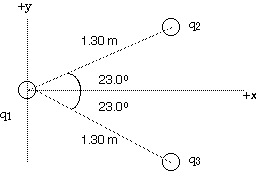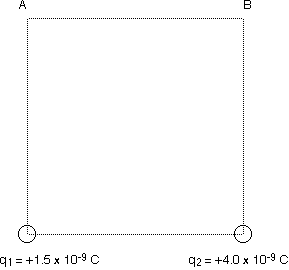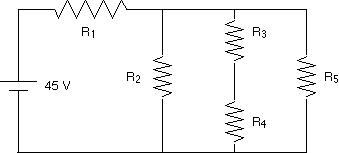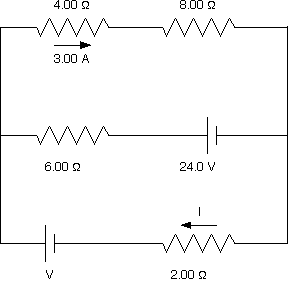Collected Problems for Test 1
Problem #1 (Due 1/22 Wednesday by 9:00 a.m.)
Three point charges are fixed in place as shown in the diagram below. The charge at the origin has a value of q1 = +7.00 microcoulumbs; the other two have identical magnitudes, but opposite signs: q2 = -4.00 microcoulumbs and q3 = +4.00 microcoulumbs.
a) Determine the net force (magnitude and direction) exerted on q1 by the other two charges.
b) If q1 had a mass of 1.50 g and were free to move, what would be its acceleration?

*Be careful with units and significant figures and make sure you look over the assignment guidelines before handing this in. Also make sure you put your name on the front and back of your paper.
Problem #2 (Due 1/24 Friday by 9:00 a.m.)
Two charges are located on the x axis: q1 = +6.0 microcoulumbs at x1 =+4.0 cm, and q2 = +6.0 micorcoulumbs at x2 = -4.0 cm. Two other charges are located on the y axis: q3 = +3.0 microcoulumbs at y3 = +5.0 cm, and q4 = -8.0 microcoulumbs at y4 = +7.0 cm. Find the net electric field (magnitude and direction) at the origin.
Problem #3 (Due 1/31 Friday by 9:00 a.m.)
The drawing shows a square , on two corners of which are fixed different positive charges. A third charge that is negative is brought to one of the empty corners .
a) At which of the empty corners, A or B, is the potential (voltage) greater? Explain.
b) Is the electric potential energy of the third charge positive or negative? Explain.
c) For which location of the third charge, corner A or B, is the magnitude of the electric potential energy greater? Explain.
d) The length of a side of the square is L = 0.25 m. Find the electric potential energy of a charge q3 = -6.0 x 10-9 C placed at corner A and then at corner B. Compare your answers for consistency with you answers to the concept questions above.

Problem #4 (Due 2/4 Tuesday by 9:00 a.m.)
Two different capacitors have the same plate separation. However, one capacitor is made with square plates, while the other if made of circular plates. The square plates have a length L on each side, and the diameter of the circular plates is L.
a) If the same dielectric material were between the plates in each capacitor, which one would have the greater capacitance? Explain.
b) By putting different dielectric materials between the capacitor plates, the two capacitors can be made to have the same capacitance. Which capacitor should contain the dielectric material with the greater dielectric constant? Explain.
c) The capacitors have the same capacitance because they contain different dielectric materials. The dielectric constant of the material between the square plates has a value of 3.00. What is the dielectric constant of the material between the circular plates? Be sure your answer is consistent with your answers to the concept questions above.
Problem #5 (Due 2/7 Friday by 9:00 a.m.)
The circuit in the drawing contains five identical resistors. The 45 V battery delivers 58 W of power to the circuit. What is the resistance R of each resistor?

Problem #6 (Due 2/7 Friday by 9:00 a.m.)
For the circuit shown in the drawing, find the current I through the 2.00 ohm resistor and the voltage V of the battery to the left of the resistor.




